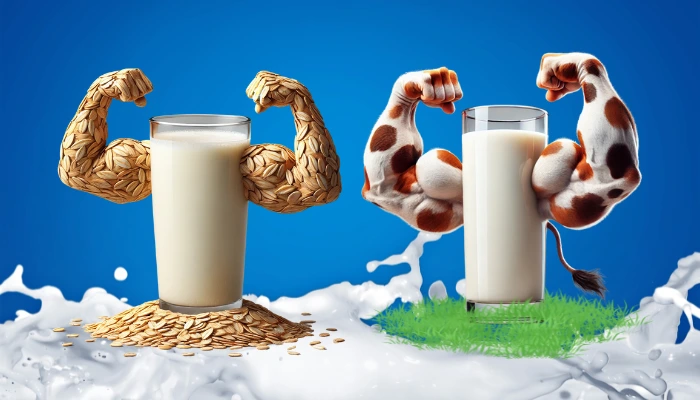Plant-based milks are on the rise, and oat milk is leading the charge. But how does it stack up against traditional cow’s milk? Let’s dive into the creamy world of oat milk and cow’s milk to find out which one is the better option for you.
Oat Milk and Cow’s Milk 101
Oat milk is made by blending oats with water and straining the mixture. This plant-based milk alternative is known for its creamy texture and slightly sweet taste. It’s a favorite among vegans and those with lactose intolerance. The popularity of oat milk has soared in recent years, making it a trendy choice in coffee shops and grocery stores.
Cow’s milk, available in whole, 2%, 1%, and skim (nonfat) varieties, is a dietary staple. It’s packed with essential nutrients like protein, calcium, and vitamins. The American Academy of Pediatrics recommends whole cow’s milk for children under 2, but adults have more flexibility in their choices.
Nutritional Breakdown
Caloric Content Comparison
Oat milk tends to have more calories than nonfat milk due to its natural carbohydrate content. This makes it energy-dense, which can be beneficial for those needing extra calories. Nonfat milk, with its lower fat content, is a suitable choice for those watching their calorie intake. A cup of oat milk usually contains about 120-130 calories, while nonfat milk has around 80 calories per cup.
Protein Content
Protein is crucial for muscle repair and growth. Nonfat milk leads with higher protein content compared to oat milk. A cup of nonfat milk provides about 8 grams of protein, while oat milk typically offers 3-4 grams of protein. However, fortified oat milk can provide comparable protein levels, making it a viable option for those on a plant-based diet. Plant-based protein options like pea milk and soy milk are also good sources of protein.
Vitamins and Minerals
Nonfat milk shines with its natural calcium content, essential for bone health. It also provides vitamin D and vitamin B12, crucial for overall health. Oat milk, often fortified with vitamins like D and B12, can offer similar benefits. Always check the labels, as fortification varies by brand. Some oat milks are fortified to provide 20-30% of the daily value of calcium and vitamin D per cup.
Dietary Considerations
Lactose Intolerance and Veganism
Oat milk is naturally lactose-free, making it a great choice for those with lactose intolerance. It’s also vegan, aligning with plant-based diets. Nonfat milk, derived from cow’s milk, isn’t suitable for vegans but is an excellent source of essential nutrients for those without lactose issues. Plant-based milk alternatives like almond milk, soy milk, and coconut milk also offer lactose-free options.
Celiac Disease and Gluten Sensitivity
Certified gluten-free oat milk is available for those with celiac disease or gluten sensitivity. Nonfat milk is naturally gluten-free, making it safe for these individuals as well. It’s important to choose oat milk made from certified gluten-free oats to avoid gluten contamination.
Health Benefits
Both oat milk and nonfat milk have their health perks. Here’s a breakdown of the key benefits for each:
- Oat Milk:
- Rich in Fiber: Oat milk contains a significant amount of fiber, which aids in digestion and helps regulate blood sugar levels.
- Beta-Glucans: This type of soluble fiber found in oat milk supports heart health by lowering cholesterol levels.
- Vitamin E: Oat milk is a good source of vitamin E, which is essential for maintaining healthy skin and a robust immune system.
- Iron: It also contains iron, which is crucial for energy production and preventing iron-deficiency anemia.
- Nonfat Milk:
- High-Quality Protein: Nonfat milk provides a substantial amount of protein, which is essential for muscle repair, growth, and overall body function.
- Calcium: This type of milk is an excellent source of calcium, vital for maintaining strong bones and teeth.
- Low in Fat: With minimal fat content, nonfat milk is a good option for those looking to reduce their fat intake without sacrificing essential nutrients.
Both oat milk and nonfat milk can be part of a balanced diet, supporting overall health and well-being. Whether you choose oat milk for its fiber and heart health benefits or nonfat milk for its protein and calcium, both options contribute to a healthy lifestyle.
Environmental Impact
Water Usage and Carbon Footprint
Oat milk production uses less water compared to cow’s milk. It’s also less carbon-intensive, making it a greener choice. However, it’s worth noting that oat milk uses more land resources compared to soy, rice, and almond milks. Additionally, cows provide meat, a byproduct that oat milk doesn’t offer. This aspect is conveniently overlooked in marketing campaigns.
Marketing Hype and Greenwashing
Oat milk is often marketed as a sustainable choice. While it’s true that oat milk uses less land and water resources than cow’s milk, it uses more land compared to soy, rice, and almond milks.
Cow’s milk is also part of a multiple purpose agricultural cycle. It provides milk, meat, and leather. Whereas oat milk provides us with only milk.
Marketing campaigns sometimes exaggerate the environmental benefits, a practice known as greenwashing. Consumers should be aware of these tactics when making their choice.
Taste, Texture, Creaminess and Flavor Profiles
Everyone seems to be obsessed with terms like flavor profiles and texture experience and mouthfeel these days. But what’s behind those experiences?
Oat milk’s creamy texture makes it a favorite in coffee and smoothies. It has a sweet taste that complements many recipes due to its added sugar. Nonfat milk is lighter and more neutral, allowing other flavors to shine through. Your choice depends on personal preference and culinary use.
But what popularized oat milk on the national stage? Starbucks! Oat milk is often used to make oat milk lattes due to its ability to froth well. In fact, Starbucks oat milk contains 7 grams of added sugar per 8-ounce serving.
And since we’re discussing oat milk’s superior frothing ability, you may want to know why that is exactly! Oat milk froths well due to its specific composition and additives that are included in store-bought versions.
Key Components for Frothing
Here’s what contributes to its frothing ability:
- Beta-Glucans: These are soluble fibers naturally found in oats. They help create a creamy texture and contribute to the stability of the foam when frothed.
- Natural Sugars: Oats contain natural sugars that caramelize and help create a rich, stable foam when heated and frothed.
- Oils: Many commercial oat milks contain added oils, like corn oil or sunflower oil, which helps it artificially create a smooth, creamy texture that froths well. These oils provide fat content that enhances the mouthfeel and frothability as well. So, the creaminess that oat milk is known for is thanks to added oils and not the oats!
- Emulsifiers and Stabilizers: Additives like gellan gum and dipotassium phosphate are often used in oat milk to improve texture and stability. These ingredients help maintain the integrity of the foam, making it last longer.
Potential Drawbacks
Added Sugars and Fat Content
Store-bought oat milks contain added sugars, so opt for unsweetened versions to limit sugar intake along with the added oils, emulsifiers, and stabilizers.
After all, oat milk isn’t naturally occurring like cow’s milk. It’s not milk. It’s a heavily manufactured drink product.
Unsweetened oat milk is a better option if you’re watching your sugar intake. Always check the nutritional profile on the packaging to avoid unnecessary added sugars.
Potential Allergens
Oat milk is a safe alternative for those with nut allergies, unlike almond milk. However, those with gluten sensitivity should choose certified gluten-free options. Nonfat milk, while lactose-free versions are available, can still pose issues for those with dairy allergies. Rice milk and hemp milk are other plant-based options for those with multiple food sensitivities.
Comparison Chart: Oat Milk vs Whole Milk, 2%, and Skim Cow's Milk
| Category | Oat Milk | Whole Milk | 2% Milk | Skim Milk |
|---|---|---|---|---|
| Nutrition (per 1 cup / 240 ml) | ||||
| Calories | ~120 | ~150 | ~120 | ~80 |
| Total Fat | ~5 g | ~8 g | ~5 g | 0 g |
| Saturated Fat | ~0.5 g | ~5 g | ~3 g | 0 g |
| Protein | ~3 g | ~8 g | ~8 g | ~8 g |
| Carbohydrates | ~16 g (7 g added sugar typical) | ~12 g (lactose) | ~12 g | ~12 g |
| Fiber | ~2 g (beta-glucan) | 0 g | 0 g | 0 g |
| Calcium | ~350 mg (fortified) | ~275 mg | ~295 mg | ~300 mg |
| Vitamin D | Fortified ~100 IU | Fortified ~120 IU | Fortified ~120 IU | Fortified ~120 IU |
| Other Nutrients | Iron (1 mg), some B vitamins (fortified). | Potassium (~350 mg), B12, riboflavin, phosphorus. | Similar to whole milk with less fat. | Same minerals, vitamins as 2%/whole but fat-free. |
| Health Context | ||||
| Lactose tolerance | Naturally lactose-free | Contains lactose | Contains lactose | Contains lactose |
| Diet fit | Vegan, dairy-free, fiber content. | Higher sat fat; nutrient dense. | Balanced fat/protein. | Low-calorie, high protein/calcium. |
| Environmental Considerations | ||||
| Carbon footprint | Lower (~0.3–0.5 kg CO₂e per liter) | Higher (~3 kg CO₂e per liter) | Similar to whole (~3 kg) | Similar to whole (~3 kg) |
| Water use | Moderate; ~48 liters per cup (mainly crop irrigation) | High; ~120 liters per cup (feed, animal care) | High; similar to whole | High; similar to whole |
| Land use | Relatively low | High (grazing/feed crops) | High | High |
| Price (average US retail) | ||||
| Cost per half gallon | $4–$5 | $2.50–$3.50 | $2.50–$3.50 | $2.50–$3.50 |
| Quick Takeaways | ||||
| Bottom line | Good plant-based option; higher carbs; lower protein; eco-friendlier. | Nutrient-dense but high sat fat and environmental cost. | Middle ground: lower fat than whole, still nutrient-rich. | Low-calorie, high protein/calcium, least fat but watery taste. |
Why is 1% cow’s milk missing from the chart? It’s the least popular milk. 2% milk outsells 1% by a wide margin.
FAQ: Oat Milk vs Cow's Milk
Q: Is oat milk a scam?
A: That depends on your perspective but all in, we think so. In fact, we wrote an article about it.
Q: Is oat milk healthier than cow’s milk?
A: No, because it depends on your dietary needs. Oat milk is rich in fiber and often fortified with vitamins, while cow’s milk provides high-quality protein and natural calcium. Both have unique health benefits.
Q: Can you froth oat milk like cow’s milk?
A: Yes, oat milk froths well due to its beta-glucans, sugars, added oils, and stabilizers like gellan gum. It’s a popular choice for lattes and other frothy beverages.
Q: Does oat milk contain more calories than cow’s milk?
A: Generally, yes. Oat milk typically has 120-130 calories per cup, while skim cow’s milk has about 80 calories per cup. Whole milk has about 150 calories per cup, but with that you’re getting more nutritional value.
Q: Is oat milk a good option for people with lactose intolerance?
A: Absolutely. Oat milk is naturally lactose-free, making it an excellent alternative for those with lactose intolerance.
Q: How does the protein content of oat milk compare to cow’s milk?
A: Cow’s milk contains more protein, with about 8 grams per cup. Oat milk usually has 3-4 grams per cup, though fortified versions may have more.
Q: What are the environmental impacts of oat milk vs cow’s milk?
A: Oat milk generally has a lower environmental impact, using less water and producing fewer greenhouse gases than cow’s milk. However, it uses more land compared to other plant-based milks like soy and almond.
Q: Can people with gluten sensitivity drink oat milk?
A: Yes, but they should choose oat milk made from certified gluten-free oats to avoid gluten contamination.
Q: What are the health benefits of oat milk?
A: Oat milk is rich in fiber, aids digestion, regulates blood sugar, and supports heart health with beta-glucans. It’s also a good source of vitamin E and iron.
Q: Is oat milk suitable for a vegan diet?
A: Yes, oat milk is plant-based and suitable for vegans. It’s a popular choice among those avoiding animal products.
Q: How does the taste of oat milk compare to cow’s milk?
A: Oat milk has a creamy texture and a slightly sweet, nutty flavor. Nonfat cow’s milk is lighter and more neutral in taste.
Q: Are there any allergens in oat milk?
A: Oat milk is generally safe for those with nut allergies. However, people with gluten sensitivity should choose certified gluten-free oat milk.
Q: Does oat milk contain added sugars?
A: Some store-bought oat milks contain added sugars. It’s best to choose unsweetened versions to limit sugar intake.
Q: How does oat milk’s nutritional profile compare to cow’s milk?
A: Oat milk is often fortified with calcium, vitamin D, and B12. Cow’s milk naturally contains these nutrients, along with higher protein levels. Both can be part of a balanced diet.
Q: What are some other non-dairy milk alternatives?
A: Other popular non-dairy milk alternatives include almond milk, soy milk, coconut milk, rice milk, and hemp milk. Each has its own unique nutritional profile and benefits.
Conclusion
Choosing between oat milk and cow’s milk depends on your nutritional needs, dietary preferences, and environmental concerns.
Oat milk offers a creamy, lactose-free alternative that’s kinder to the planet, but may come with marketing hype.
Nonfat milk provides higher protein and essential nutrients for those without lactose issues.
Whether you prefer the nutty sweetness of oat milk or the familiarity of nonfat milk, both can be part of a healthy, balanced diet. Make your choice based on what suits your lifestyle and health goals best.


















